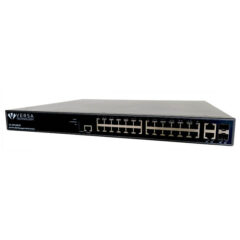Businesses can replace LED lights’ electrical power source with an alternate but common power source found in the networking world— Power over Ethernet (PoE). Versa Technology’s PoE Switches pair well with LED lighting installations.
Recommended Devices for PoE Lighting Applications
VX-GPU2626 (V2) L2+ 24-Port Managed GbE UPOE Switch (2000W)
The VX-GPU2626 (V2), from Versa Technology, delivers 24 10/10/100TX UPOE ports (802.3bt/at/af, and total of 2000W), 2 Combo 100/1000X SFP TX ports and RJ45 Console port.
- Ports: 24 10/100/1000TX PoE + 2 100/1000 SFP/TX
- Type of Switch: Managed
- PoE Ports: 24
- Standards: Ultra PoE 802.3bt Ready, 802.3at
- PoE Power Budget: 2000W
- Operating Temp: 0 to 40°C
- Input Voltage: 115-240VAC
- Forwarding Capacity: 36.68Mpps
- Includes: 2 x 1000W Power Supply
VX-GPU2610-9 L2+ 8-Port 10/100/1000TX 90W 802.3bt PoE + 2-Port 100/1000X SFP Managed Switch (740W PoE budget, DMS)
The VX-GPU2610-9 delivers 8 UPOE ports (802.3bt/at/af, and total of 740W), 8 10/10/100TX ports, 2 Combo 100/1000X SFP TX ports and RJ45 Console port.
- Ports: 8 802.3bt PoE + 8 10/100/1000TX + 2 100/1000TX SFP
- Type of Switch: Managed
- PoE Ports: 8
- Standards: Ultra PoE 802.3bt Ready, 802.3at/af
- PoE Power Budget: 740W (90W per port)
- Input Voltage: 100~240VAC
- Forwarding Capacity: 14.88Mpps
- Operating Temp: 0 to 40°C
- UL Listed
FAQ's on PoE LED Lighting
Is PoE efficient?
PoE technology comes with significant energy efficiency benefits. Across devices, it can save up to 50% in energy compared to traditional wiring methods. For lighting in particular, the DC connection to LED lighting sources alone can save up to 20% in electricity costs in addition to the other efficiency benefits.
How does PoE benefit my business?
PoE benefits your business in various ways, from increasing cost savings and prioritizing sustainability to increasing the health and productivity of your employees. At the same time, it also introduces a significant element of flexibility into your physical setup. More flexible power sources can increase the use of smart technology throughout the building and move individual devices around without significantly increased costs.
What are the disadvantages of PoE Lighting?
Despite its significant advantages, PoE lighting is not a magic solution. Some disadvantages of the technology include:
- Wattage limits, especially with older Ethernet cabling, can only support lighting up to 30W.
- Security concerns from the building network expand to its lighting. If the larger network is breached, lighting can also be controlled.
- Potential for outages, especially in installations where a single connection supports multiple devices or luminaires.
- Distance limits require extenders to supply power for any cabling longer than 100 meters or 300 feet.
What lighting platforms can help with PoE products?
The recent rise of technology has led several manufacturers to use PoE lighting products for installation. Versatek has partnered and built relationships with five manufacturers based on the quality of their product and their strategic leadership in the field:
- Platformatics
- IGOR
- Genisys
- NuLEDs
- Cree
Can my PoE LED lighting become a security vulnerability?
Because PoE powers smart devices, any device connected via ethernet (including lighting sources) are potentially vulnerable to cyber-attacks. Potential intruders could gain remote access over the lighting controls remotely, turning them on or off and changing the warmth and type of lighting without needing to be in the building.
However, it’s important to note that this risk is not elevated for lighting compared to other connected devices throughout the building. As long as building managers follow cybersecurity best practices, including adequate encryption and authentication, using secure products, and protecting the network, smart lighting systems tend to be safe. That’s especially true considering that once intruders gain access to the network, lighting is not likely to be a priority for gaining control and other malicious acts.
How can I optimize my PoE lighting Setup?
PoE lighting installers consider five distinct variables when optimizing their lighting setups to improve efficiency, occupant health, and productivity:
- Physical layout, including the placement of art and furniture throughout the building.
- Lighting types, with different types complementing each other. Lighting is often planned in layers, with functional lighting first followed by task-based and accent lights.
- Lighting colors should match the furniture and colors in the room and the ideal mindset of the occupants within the space.
- Lighting balance, with the color and type of light balancing out the rest of the environment in which the light will be visible.
- Room purpose, with different lights fulfilling different purposes for their audience. For example, communal seating areas require more light than storage or focus areas.
How soon can I expect to see a return on my investment?
The ultimate return on investment for your PoE lighting installation depends on the scope of the installation and the existing network wiring and lighting sources within the building. As a general estimate, and thanks to its multi-faceted cost savings, a $15,000 investment in PoE lighting across a commercial building can return its initial investment within the first five years of installation.
Insights from the Blog
Other PoE LED Lighting Resources
We're Here to Help!
Not sure which PoE Device is right for you? Send us a short message here and a Versa technical partner will assist you shortly. Have an urgent need? Use the chat below during regular business hours.
What is Power over Ethernet?
Power over Ethernet, or PoE for short, is a technology that can transmit power and data via a standard Ethernet cable. PoE allows network administrators to deploy Powered Devices (PD's) at nearly any location. Watch the following video for a quick rundown.
Stay Up to Date with our News
and Exclusive Offers
Join our expansive group of IT professionals who receive exclusive offers and the latest developments in the Telecom and Networking Industry.






